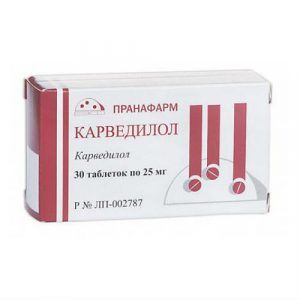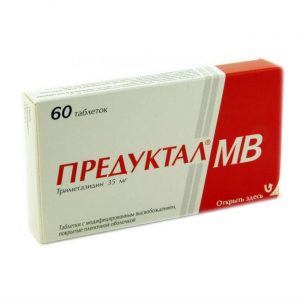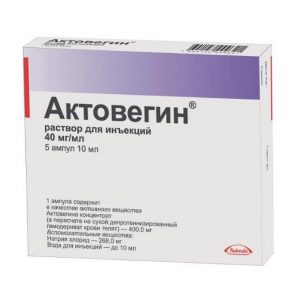Description
Pharmacological action
The derivative of dihydropyridine is a slow calcium channel blocker (BMKK), has an antianginal and hypotensive effect, blocks calcium channels, reduces the transmembrane transition to a higher transmembrane vessels than cardiomyocytes).
The antianginal effect is due to the expansion of the coronary and peripheral arteries and arterioles: with angina pectoris it reduces the severity of myocardial ischemia by expanding peripheral arterioles, reduces total peripheral vascular resistance (OPSS), reduces the afterload on the heart, and reduces myocardial oxygen demand. Expanding the coronary arteries and arterioles in the unchanged and ischemic zones of the myocardium, increases the flow of oxygen into the myocardium (especially with vasospastic angina pectoris) prevents spasm of the coronary arteries (including caused by smoking).
In patients with stable angina pectoris, a single daily dose increases exercise tolerance, increasing the time before the onset of angina pectoris and ischemic depression of the ST segment, reduces the frequency of angina attacks and consumption of nitroglycerin and other nitrates.
Has a prolonged dose-dependent hypotensive effect. The antihypertensive effect is due to a direct vasodilating effect on the smooth muscles of blood vessels. In case of arterial hypertension, a single dose provides a clinically significant decrease in blood pressure (BP) over 24 hours (in the patient ² ¢s position, lying and standing).
Orthostatic hypotension with the appointment of amlodipine is quite rare.
Does not cause a decrease in left ventricular ejection fraction.
Reduces the degree of left ventricular myocardial hypertrophy.
Does not affect myocardial contractility and conductivity, does not cause a reflex increase in heart rate (HR), inhibits platelet aggregation, increases glomerular filtration rate, has a weak natriuretic effect.
In diabetic nephropathy does not increase the severity of microalbuminuria.
It does not adversely affect the metabolism and concentration of blood lipids and can be used in the treatment of patients with bronchial asthma, diabetes mellitus and gout.
A significant decrease in blood pressure is observed after 6-10 hours, the duration of the effect is 24 hours.
In patients with diseases of the cardiovascular system (CVS) (including coronary atherosclerosis with damage to one vessel and up to stenosis of 3 or more arteries, atherosclerosis of the carotid arteries ) after myocardial infarction, percutaneous transluminal coronary angioplasty (PTCA) of coronary arteries or patients with angina pectoris, the use of amlodipine prevents the development of a thickening of the intima-media of the carotid arteries, reduces mortality from myocardial infarction, stroke, PTCA, aorto-coronary bypass surgery leads to a decrease in the frequency of attacks of unstable angina and the progression of chronic heart failure (CHF) reduces the frequency of interventions aimed at restoring coronary blood flow.
Does not increase the risk of death or the development of complications and deaths in patients with heart failure (III-IV functional class according to NYHA classification) during therapy with digoxin, diuretics and angiotensin converting enzyme inhibitors (ACE). In patients with heart failure (III-IV functional class according to NYHA classification) of non-ischemic etiology with the use of amlodipine, there is a possibility of pulmonary edema.
Pharmacokinetics:
After oral administration, amlodipine is slowly absorbed from the gastrointestinal tract (GIT).
The average relative bioavailability is 64-80%, the maximum concentration (Css) in the blood serum is observed after 6-12 hours. Equilibrium concentrations (Css) are reached after 7-8 days of therapy.
Food intake does not affect amlodipine absorption. The average distribution volume is 21 l / kg body weight, which indicates that most of the drug is in the tissues, and a smaller part is in the blood. Most of the drug in the blood (97.5%) binds to plasma proteins.
Amlodipine undergoes a slow but active metabolism in the liver in the absence of a significant effect of the primary passage through the liver. Metabolites do not have significant pharmacological activity.
After a single dose, the half-life (T1 / 2) varies from 35 to 50 hours, with repeated administration, T1 / 2 is approximately 45 hours.
About 60% of the ingested dose is excreted by the kidneys mainly in the form of metabolites, 10% unchanged, and 20-25% through the intestines with bile. The total clearance of amlodipine is 0.116 ml / s / kg (7 ml / min / kg, 0.42 l / h / kg).
In elderly patients (seniore 65 years) the excretion of amlodipine is slowed down (T1 / 2 – 65 hours) compared with young patients, but this difference has no clinical significance.
Elongation of T1 / 2 in patients with liver failure suggests that with prolonged use, the cumulation of the drug in the body will be higher (T1 / 2 – up to 60 hours). Renal failure does not significantly affect the kinetics of amlodipine.
Amlodipine crosses the blood-brain barrier.
Hemodialysis is not removed.
Indications
– Arterial hypertension (in monotherapy or in combination with other antihypertensive drugs)
– stable angina pectoris
– vasospastic angina pectoris (Prinzmetal angina) (as monotherapy or in combination with other antianginal drugs).
Contraindications
– Hypersensitivity to amlodipine, other derivatives of dihydropyridine and other components of the drug
– severe arterial hypotension (systolic blood pressure less than 90 mm Hg)
– shock (including cardiogenic shock (pulmonary duct injury), srdlk , grade III aortic stenosis)
– heart failure with unstable hemodynamics after
myocardial infarction – age under 18 years (efficacy and safety have not been established).
Composition of
One tablet, 5 mg, contains:
active ingredient: amlodipine – 5,000 mg (as amlodipine besilate – 6.935 mg)
excipients: microcrystalline cellulose – 71.356 mg, calcium hydrogen phosphate dihydrate – 37.500 mg sodium metal, 500 mg sodium phosphate A) – 2,400 mg, magnesium stearate – 1,800 mg.
Side effects of
The frequency of occurrence of adverse reactions was determined in accordance with the Classification Organization protection: very often ( 1/10) often ( 1/100 and <1/10) infrequently ( 1/1000 and <1/100) rarely ( 1/10000 and <1/1000) very rarely (< 1/10000), the frequency is unknown (cannot be calculated based on available data). In each frequency group, adverse reactions are presented in descending order of severity. Disorders from the blood and lymphatic system: very rarely – thrombocytopenic purpura, leukopenia, thrombocytopenia. Immune system disorders: infrequently – itchy skin, rash (including erythematous, maculopapular rash, urticaria) very rarely – allergic reactions, Quincke’s edema, angioedema, Stevens-Johnson syndrome, exfoliative dermatitis, erythema multiforme. Disorders from metabolism and nutrition: infrequent – increase / decrease in body weight rarely – increased appetite very rarely – hyperglycemia. Mental disorders: infrequently – depression, mood lability, insomnia, unusual dreams, increased irritability, anxiety is rare – confusion is very rare – apathy, agitation. Disorders of the nervous system: often – drowsiness, headache (especially at the beginning of treatment), dizziness infrequently – hypesthesia, paresthesia, tremor, insomnia, fainting, dysgeusia very rarely – hypertonicity, migraine, increased sweating, peripheral neuropathy, ataxia, amne frequency unknown – extrapyramidal disorders. Disorders of the organ of vision: often – diplopia, impaired accommodation infrequently – xerophthalmia, conjunctivitis, eye pain. Hearing disorders and labyrinth disorders: infrequently – ringing in the ears. Heart abnormalities: often – palpitations infrequently – heart rhythm disturbances (including bradycardia, ventricular tachycardia and atrial fibrillation) is very rare – myocardial infarction, the development or aggravation of CHF. Vascular disorders: often – flushing of the face skin infrequently – excessive decrease in blood pressure is very rare – vasculitis, orthostatic hypotension. Disorders of the respiratory system, chest and mediastinal organs: often – shortness of breath infrequently – cough, rhinitis, nosebleeds very rarely – parosmia. Disorders of the gastrointestinal tract: often nausea, abdominal pain, dyspepsia, constipation or diarrhea infrequently – vomiting, flatulence, dry oral mucosa, thirst very rarely – pancreatitis, gastritis, gingival hyperplasia. Violations of the liver and biliary tract: very rarely – jaundice, increased activity of hepatic transaminases (usually in combination with cholestasis), hepatitis, hyperbilirubinemia. Disorders from the skin and subcutaneous tissues: frequent – peripheral edema (ankles and feet), infrequently – alopecia, increased sweating, impaired skin pigmentation is very rare – xeroderma, cold sweat, photosensitivity frequency unknown – toxic epidermal necrolysis. Violations of the musculoskeletal and connective tissue: often – muscle cramps infrequently – arthralgia, myalgia, back pain, arthrosis rarely – myasthenia gravis. Disorders from the kidneys and urinary tract: infrequently – frequent urination, painful urination, nocturia is very rare – dysuria, polyuria. Disorders from the genitals and mammary gland: infrequently – erectile dysfunction, gynecomastia. General disorders and disorders at the injection site: often – increased fatigue, asthenia infrequently – chest pain, general malaise. Drug Interactions Amlodipine can be safely used to treat hypertension with thiazide diuretics, alpha-blockers, beta-blockers or ACE inhibitors. In patients with stable angina pectoris, amlodipine can be combined with other antianginal agents, for example, prolonged or short-acting nitrates, beta-blockers. Taking amlodipine with grapefruit or grapefruit juice is not recommended, as in some patients the bioavailability of amlodipine may increase, which leads to an increase in its antihypertensive effect. CYP3A4 isoenzyme inhibitors Concomitant use of amlodipine with strong or moderate CYP3A4 isoenzyme inhibitors (HIV protease inhibitors, azole antifungal drugs, macrolides such as erythromycin or clarithromycin, veramapil or diltiazim may increase, resulting in an increase in amlitipin), which can lead to an increase in amlipitasin) the risk of a sharp decrease in blood pressure. The clinical manifestations of these simultaneous use options may be more pronounced in patients over 65 years of age, medical supervision is necessary for the possible correction of drug doses. Inducers of the isoenzyme CYP3A4 The simultaneous use of inducers of the isoenzyme CYP3A4 can lead to a change in the concentration of amlodipine in blood plasma. It is necessary to control blood pressure, you should consider the possibility of dose adjustment of amlodipine during and after simultaneous administration, especially with strong inducers of the CYP3A4 isoenzyme (for example, rifampacin, St. John’s wort perforated). Dantrolene (infusion) In animals, ventricular fibrillation and fatal cardiovascular collapse were observed along with hyperkalemia following verapamil and intravenous dantrolene. Due to the risk of developing hyperkalemia, it is recommended to avoid the simultaneous use of BMCC, such as amlodipine, in patients with a predisposition to malignant hyperthermia, as well as in the treatment of malignant hyperthermia. In clinical trials of drug interactions, amlodipine did not affect the pharmacokinetics of atorvastatin, digoxin, and warfarin. It is possible to enhance the antianginal and hypotensive effect of BMCC with simultaneous use with thiazide and loop diuretics, verapamil, ACE inhibitors, beta-blockers and nitrates, as well as increase their hypotensive effect with simultaneous use with alpha1-blockers, isoflurane, antipsychotics. simvastatin The simultaneous use of multiple doses of 10 mg of amlodipine and 80 mg of simvastatin led to a 77% increase in simvastatin exposure compared to simvastatin monotherapy. In patients receiving amlodipine, the dose of simvastatin should not exceed 20 mg per day. Tacrolimus The simultaneous use of tacrolimus with amlodipine is characterized by a risk of increasing the concentration of tacrolimus in the blood plasma. The pharmacokinetic mechanism of this interaction is not fully understood. Patients taking amlodipine should monitor the concentration of tacrolimus in the blood plasma, as well as, if necessary, adjust the dose to avoid the toxic effects of tacrolimus. Rapamycin Target Inhibitors (mTOR) Ramapicin Target Inhibitors such as sirolimus, temsirolimus and everolimus are a substrate of the CYP3A isoenzyme. Amlodipine is a weak inhibitor of the CYP3A isoenzyme. When used concurrently, amlodipine may enhance the action of ramapicin target inhibitors. cyclosporin No clinical studies of the drug interaction of cyclosporin and amlodipine with the exception of studies involving patients after kidney transplantation, in which an increase in the variable residual concentration of cyclosporine in the blood plasma was observed (on average, by 0-40%). Attention should be paid to monitoring the concentration of cyclosporine in blood plasma in patients after kidney transplantation taking amlodipine, and also, if necessary, reduce the dose of cyclosporine. Although a negative inotropic effect was not usually observed in the study of amlodipine, some BMCCs may increase the severity of the negative inotropic effect of antiarrhythmic drugs that prolong the QT interval (for example, amiodarone and quinidine). Calcium preparations may reduce the effect of BMCC. With the simultaneous use of amlodipine with lithium preparations, symptoms of lithium neurotoxicity may increase (nausea, vomiting, diarrhea, ataxia, tremor, tinnitus). Effect of amlodipine on other drugs The hypotensive effect of amlodipine enhances the effect of antihypertensive drugs. Overdose Symptoms: marked decrease in blood pressure with possible development of reflex tachycardia, excessive peripheral vasodilation (risk of severe and persistent arterial hypotension, including with the development of shock and death). Treatment: gastric lavage, intake of activated charcoal (especially in the first 2 hours after an overdose), maintaining the function of the cardiovascular system, the patient should take a horizontal position with an elevated position of the lower extremities, monitoring the performance of the heart and lungs, circulating blood volume (BCC) and diuresis. To restore vascular tone – the use of vasoconstrictors (in the absence of contraindications to their use) to eliminate the effects of calcium channel blockade – intravenous administration of calcium gluconate. Hemodialysis is ineffective. Storage conditions Store at a temperature not exceeding 25 ° C in the original packaging. Keep out of the reach of children. Active ingredient Amlodipine Terms of sale from pharmacies Prescription lekarstvennaja form tablets Appointment Adult prescription Indications Hypertension, Angina



